|
Maurice Marrs was born January 13, 1900 and died April 10, 1976.
In between, he led the consummate life of the Golden Age aviator. For this page, we are fortunate to have dedicated (and international) Marrs biographers (cited, right sidebar) sharing with us excellent information and photographs.
There is not a lot of information available about Marrs on the Web, which is surprising given his skills and accomplishments. Early on he engaged in the obligatory Golden Age barnstorming. An article in Oklahoma Today (cited, left sidebar) states, "Brigadier General Maurice Marrs, who retired recently as the Oklahoma State Air Officer to become manager of Tulakes Airport recalls one such incident. He and Tip Schier and Bob Cantwell were barnstorming and ran out of money in Seminole. Fortunately they had a guitar with them. General Marrs put on dark glasses, took the guitar and a tin cup. His companions stationed him on the main street and left him. Marrs recalls he took in some twenty or thirty dollars-enough to get out of town. 'But they left me all day,' he said, 'and I was afraid to get up and move around.' A nostalgic grin broke the pleasantness of the General's face. 'Seminole was a pretty tough town in those days.'"
First things first. Marrs signed the Tucson Register four times. His first two visits reveal an interesting conjecture. For those landings, on September 11 & 17, 1928, he was flying Travel Air NX6239 (clearly written both times in the Register). On the 11th he was westbound from El Paso, TX to Yuma, AZ. On the 17th, he was eastbound from San Diego, CA. Solo on his first landing, he carried Milton Mullins as his single passenger the second time. The purpose of his first visit was his competition in the National Air Races (NAR) that year.
I offer this detail, above, because there is a discrepancy in his pilot log book, below, as to the registration number of the airplane he was flying. As well, there is a discrepancy in the make of his airplane in the official Aircraft Yearbook (the volume for 1929) results summary of the 1928 NAR. With a little digging, the question of airplane brand is easily resolved. The registration number is still in question. Please follow my logic, below.
Below, from Mr. Erikson, the page from Marrs' pilot log book that summarizes his flights with an airplane identified as "6238" between September 9 and 19, 1928. I cleaned this image with PhotoShop to enhance readability. It is clear he wrote 6238 in this log. Parenthetically, note that he had accumulated 573 flight hours up to that time.
Maurice Marrs, Pilot Log Book, September, 1928 (Source: Eriksen)
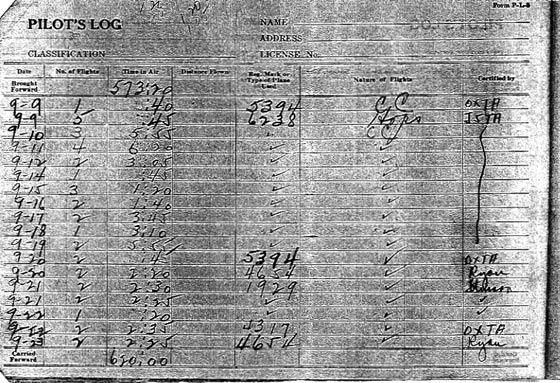 |
What about the registration number? Clearly written, the airplane Marrs signed into the Davis-Monthan Register on September 11 and 17, 1928 was 6239, not 6238. According to his pilot log, his experience with 6238 began on September 9th with five brief "hops" flown in 45 minutes. On the 10th he departed Oklahoma City on a "CC," or cross-country, flight. These dates, inclusive, are consistent with his landings at Tucson.
According to aerofiles.com, 6238 was a Travel Air 2000, S/N 689, which was later converted to a model S-2000. The other, 6239, left the factory as a Travel Air D-2000, S/N 690, later modified to a D-4000. Both Travel Airs; both cited as being on cross-country trips on the 11th and 17th of September, 1928. Did Marrs make a mistake writing the number in our Register? Or did he write it wrong in his pilot log? Can anyone CLARIFY the registration number of the airplane Marrs was flying in the 1928 NAR?
What about his brand of airplane? According to the Aircraft Yearbook for 1929, page 431, Marrs was flying a Lockheed aircraft (not a Travel Air), and placed 10th in the NAR Class B cross-country event from New York to Los Angeles. According to the Lockheed reference by Allen, there was no Lockheed aircraft ever manufactured with the registration numbers 6238 or 6239. Perhaps the Yearbook got the model wrong. What we do know is that Marrs was flying a Travel Air through Tucson, whichever the registration number.
Marrs' third and fourth visits to Tucson were cited as being in Lockheed aircraft. On Monday, April 15, 1929, he landed in Lockheed Vega NX7429. Based at Tulsa, OK, he carried three unidentified passengers. They were apparently on a round-robin flight from Tulsa back to Tulsa. The airplane, painted yellow, had been raced by Robert Cantwell in 1928 NAR as plane #22, and won the Class C cross-country event.
His final solo visit to Tucson was in Lockheed Vega NC433E on Sunday, November 9, 1930. He was eastbound from Los Angeles, CA (probably the Lockheed factory at Burbank) to Oklahoma City, OK. Marrs was probably ferrying the airplane to Braniff. Please direct your browser to the airplane's page for further details.
Below, a summary of Marrs' life written by Eriksen and granddaughter Havrilla. I have inserted some of their images where appropriate.
"Brigadier General Maurice A. Marrs was born January 13, 1900 in Coffeyville, Kansas. The family moved to Oklahoma City in the early 1900’s where Marrs attended grade school and high school. He attended Wentworth Military Academy for two years and Missouri Military Academy, graduating as a Second Lieutenant. Marrs also attended the University of Oklahoma from 1919 to 1920 where he studied geology.
"In 1915 Marrs and his father attended the Panama-Pacific International Exposition (World’s Fair) in San Francisco. The high point of the fair visit was a five minute ride in a Curtiss pusher biplane. From that day he was sold on aviation. Taking lessons in Oklahoma City in an old World War I surplus Jenny, Marrs got his pilot’s license in 1923, bought himself a Jenny and thus he became a barnstormer.
"[Later in the 1920s] Marrs became the first pilot for Paul Braniff. He flew the 116-mile route between Oklahoma City and Tulsa in a single engine, five passenger Stinson Detroiter. From Braniff Airlines he went to Southwest Air Fast Express [SAFE]. Then to Safeway Airlines. After a short while he began with National Air Transport (NAT).
"In 1929, Marrs enlisted in the Air Corps Reserve as a private and was promoted to Sergeant in the Army signal corps. In June 1930 he was commissioned as a 2nd Lt. in the Air Corps Reserve. He remained in the Air Corps Reserve during the years leading up to World War II.
Maurice Marrs Identification Card, 1938 (Source: Havrilla)
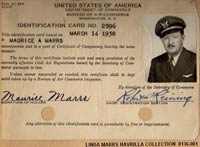 |
"In 1931 Marrs began flying for United Air Lines. [On] March 17, 1936 he piloted a routine flight from Newark, N.J. to Cleveland, Ohio. Extremely difficult weather conditions occurred. He maneuvered his plane to a forced landing on a farm with great skill and courage. The landing in the blinding snowstorm was perfect. It was expressed in the news [e.g. the Milwaukee Journal, March 17, 1936] that neither the ship nor its 12 occupants were the worse after a miraculous escape from death. [Later] in 1936 Marrs attended the Boeing School of Aeronautics. [Identification card, right, is from United Air Lines, dated March 14, 1938. Card, below, is from January 1, 1939, a couple of months before he left United.]
Maurice Marrs United Airlines Identification Card, 1939 (Source: Havrilla)
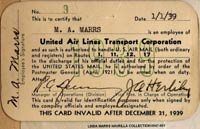 |
" In March 1939 he resigned from United Air Lines. A few weeks later he became a pilot for KLM as an airline commander stationed at Schipol airport in Amsterdam, Holland. Marrs took over regular flights on the line’s European, Indian and Far East routes: Naples, Athens, Alexandria, Jerusalem, Bagdad, Karachi, Jodhpur, Allahabad, Calcutta, Rangoon, Bangkok, Singapore and Batavia
"During the stay in Holland war clouds closed in over Europe. He returned to [the] U.S. in June 1940. His next assignment was as a test pilot at Lockheed Aircraft where he worked until March 1942. From Lockheed he was loaned to Pan American Airways where he joined in helping to launch Pan American’s South American ferry operations. The pioneering effort was accomplished after 2,000 miles across the South Atlantic to Africa when ten planes were successfully delivered. Atlantic Airways Ltd. first mission was completed. This was the start of many overseas ferry transports to come during WWII.
Maurice Marrs, Military Service Summary (Source: Havrilla)
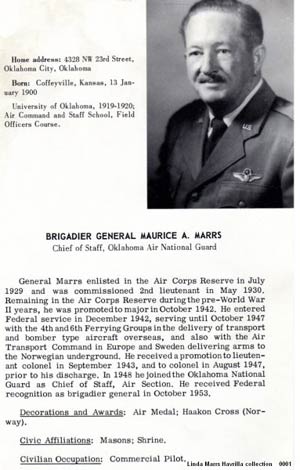 |
"On August 1942 Marrs left Pan American. Later that year he was promoted to the rank of Major in the Air Corps Reserve. On December he entered extended active duty as a technical inspector in Miami, Florida. In 1943 Marrs became the Commander of the aircraft ferrying Squadron, Air Transport Command [ATC]. Marrs flew as the pilot on approximately ten of the first trans-ocean deliveries to Africa, the Middle East and England. On September he was promoted to Lieutenant Colonel.
"From November to June 1944 Marrs was the Ferrying Division Cargo officer at Natal, Brazil. From June he assumed command of the 23rd Transport Squadron and established a military freight and passenger service up and down the Pacific coast of the U.S. In September he was assigned to the Alaskan Division, ATC, Edmonton, Alberta, Canada, awaiting further transportation to final destination.
"One month later Marrs was ordered to the US Army Air Forces Base Unit at Orly Field in France for the purpose of assisting the Operations Officer. Marrs had commercial experience and he was highly respected. So at at the end of October he was ordered to participate in USAAF’s secret operations in Scandinavia as Commanding Officer. He was base Commander for the unit at Bromma airfield, Stockholm in Sweden.
"The unit transported equipment and arms to Sweden – marked as Diplomatic mail. A courier air transport route between Stockholm in neutral Sweden and Great Britain was established. Supplies were delivered to the resistance movement in Norway and Denmark .... As part of the mission in Sweden, interned U.S. combat crews, Norwegians and a number of diplomatic personnel were flown out of Bromma.
Maurice Marrs Receives Air Medal (Source: Havrilla)
 |
"Marrs completed his assignment in Sweden at the end of 1945. From December 1945 to May 1946, Marrs was assigned to the Office of Foreign Liquidation Commission (OFLC) engaged in the disposal of surplus aircraft and engines. In May 1946 Marrs was sent to Paris to head up the aircraft disposal branch of OFLC in Europe, with offices in Paris, London and Rome. In August 1947 Marrs was transferred back to Washington and on October 1947 was separated from the Air Force.
"Following his separation from the Air Force, Marrs returned to Oklahoma, but did not abandon his passion for aviation. On the military front, he held from April 1951 the position of Commander of State for Air and was on the staff of the State Adjutant General who acted as the Governor’s military advisor. The 125th Fighter Squadron in Tulsa was the first unit in his 137th Fighter group that converted from piston engine fighters to jet fighters – the Lockheed F-80 Shooting Star in 1948.
[Mr. Eriksen says the image at left, '... is a scanned page from one of the many photo albums. It's from an event in Oslo that [took] place August 7, 1945. The two pictures show [Register pilot] Brigadier General Earl S. Hoag (commanding general of the European Division of Air Transport Command during WWII) presenting awards to Lt.Col. Marrs and the legendary aviator and Artic explorer Col. Bernt Balchen.
'The picture shows Marrs being awarded the Air Medal for distinguishing himself by meritorious achievement while participating in aerial flight as pilot of a B-24 type aircraft on special operational missions over enemy occupied territory.' Both Balchen and Hoag are Register pilots.]
"In October 1953 he received Federal recognition as Brigadier General. In the 1950’s he graduated Air Command and Staff School at the Air University. He graduated Air Ground Operations School and Senior Officer Jet Instrument School at Moody Air Force Base.
"On the civilian side he was the Base Commander for the Air National Guard, based at Will Rogers Field in Oklahoma City He maintained a close liaison with Tinker AFB and the 33rd Air Division. He was a member of the Oklahoma City Chamber of Commerce Aviation Committee having served in that capacity for several years. He worked closely with the Oklahoma City Air Defense Filter Center, Civil Air Patrol (CAP), civic groups and was called on frequently for speaking.
"Maurice A. Marrs retired as a Reserve Brigadier General and Chief of Staff for Air on the State Adjutant General’s Staff and base detachment Commander of the Air National Guard Base at Will Rogers Field January 31, 1960. The day after he became the Superintendent of Tulakes airport.
"General Marrs was the Commander of the Oklahoma Wing of the Civil Air Patrol from April 1961 to December 1965. [He] had 16,316 hours as first pilot in his log book – 12,825 as a civilian and 3,491 as a military flyer. Those hours include time in every type of transport aircraft used by airlines, from the single engined Stinson through the DC-7. It also includes time in several types of bomber and fighter planes, including 40 hours in jets....
"Marrs lived a life dedicated to aviation and to the furthering of aviation and air transport of all types. Throughout his career he received several awards and presentations. Among them the King Haakon VII’s Cross of Liberty for his effort in the libertation of Norway and the Air Medal for special operational missions over enemy occupied territory. In 1966 he was awarded the Oklahoma Distinguished Service Medal. [He] died April 10, 1976 in Oklahoma City. |
Below, two undated images of Marrs with transport aircraft. The dates could be anywhere in the late 20s to early 30s when he was working for Braniff, SAFE, NAT or United. The first is a signed photograph of Marrs standing in front of a trimotor with engines running, circa 1930s. The caption, which over the years has lifted the emulsion from the photograph, says, "With lots of love to mother." Mr. Eriksen says about this image, "The picture is probably from 1929 when he flew for the Duncan [OK] industrialist Erle P. Halliburton and the South West Fast Express (S.A.F.E.way Airlines)."
Maurice Marrs, Date, Location & Aircraft Unknown (Source: Havrilla)
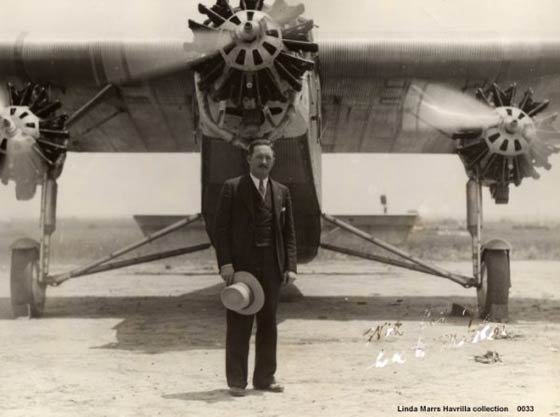 |
Next is an image of Marrs in the cockpit of a transport aircraft. The date and location are unknown. The image is a still extracted by Mr. Eriksen from a movie owned by Ms. Havrilla. Mr. Eriksen says about the image that it is, "... a Boeing 247 belonging to United Airlines."
Marrs in Cockpit of a Boeing 247 (Source: Havrilla)
 |
Site visitor Russ Plehinger adds that, while working for United Air Lines on January 10, 1933, Marrs set a speed record from Los Angeles, CA to Newark, NJ. That distance of 2,500 miles was covered in 16h 16m flying time for an average speed of 153.69 mph. Marrs flew a twin-engined Boeing 247D with Pratt & Whitney engines. This was a record for transport planes as well as for a United Air Lines plane. He also flew the Cleveland to Newark leg, 418 miles, in 2 hours 46m.
Below, a few images we need help with. All are clipped from the same movie as above. If you can identify any of the entities or circumstances below, please let me KNOW.
First, an image of a Ford trimotor named "Quick Silver." Can anyone IDENTIFY the airplane as to registration number?
Unidentified Ford, "Quick Silver" (Source: Havrilla)
 |
Second, a view from the front of a twin-engined blimp gondola. Because the gondola is detached from the envelope, this is probably one of Goodyear's earlier blimps, a Pony or Pilgrim model of the late 1920s. Or the gondola is being worked on and was detached from the envelope. Does anyone KNOW?
Twin-Engined Blimp, Date & Location Unknown (Source: Havrilla)
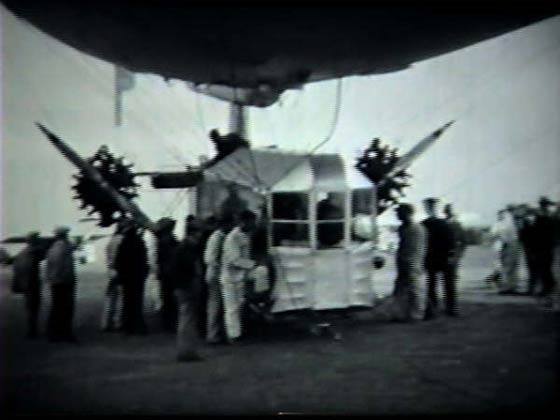 |
Third, what appears to be a Browning-Ferris Machinery Company corporate airplane with passengers. In the late 1960s, the company was bought and built into a waste management company, Browning-Ferris Industries Inc. (BFI), which stayed in business until 1999. Does anyone KNOW the circumstances of the photograph or the registration of the airplane, or the people?
Browning-Ferris Machinery Company Aircraft, Date Unknown (Source: Havrilla)
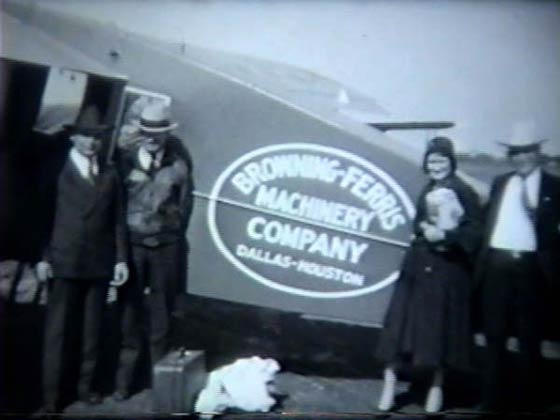 |
Fourth, an unidentified pilot in an unidentified uniform holding an infant. The pilot looks like he has a chaw of tobacco in his left cheek. Can anyone IDENTIFY the people?
Pilot With Infant, and a Woman, Date & Location Unknown (Source: Havrilla)
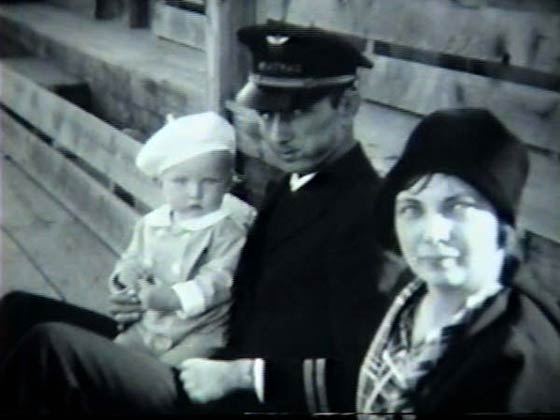 |
Fifth and sixth are pilot seat views of the left and right engines of a trimotored aircraft aloft. This would have been the view out the window on a typical cross-country commercial flight during the Golden Age. Click the shutter...
Radial Engine Aloft, Left Side, Date & Location Unknown (Source: Havrilla)
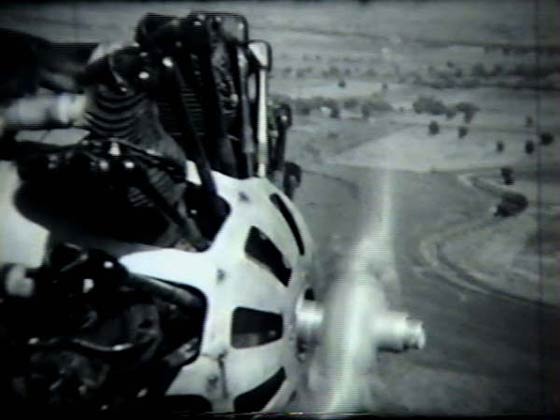 |
Now, wind, wind, wind the camera, shift position to the right and click... Below is the view out the right side cockpit window. The pitot tube and landing light are visible on the wing. Note that the altitude is not very great.
Radial Engine Aloft, Right Side, Date & Location Unknown (Source: Havrilla)
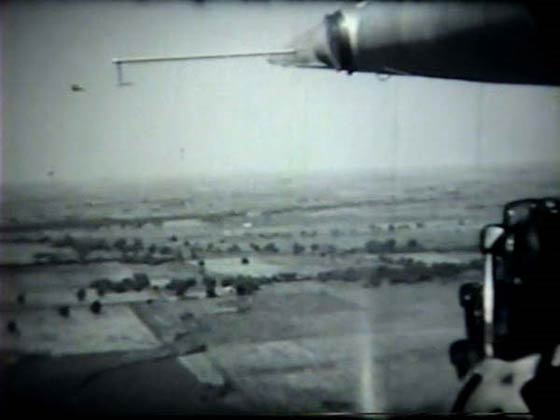 |
Seventh, a photograph of Marrs, right, with and unidentified man who appears to be pulling a sweaty shirt from his chest. Can anyone IDENTIFY the gentleman? The cylinder baffle design of the engine in the background is the same as the ones shown on the two photographs above. Perhaps this is the same airplane, and perhaps this photo captures their return to the ground.
Maurice Marrs, R, and an Unidentified Man, Date & Location Unknown (Source: Havrilla)
 |
Eighth, a trimotor with a group of passengers. This airplane is not the same one as above.
A Ford Trimotor with a Group of Passengers, Date & Location Unknown (Source: Havrilla)
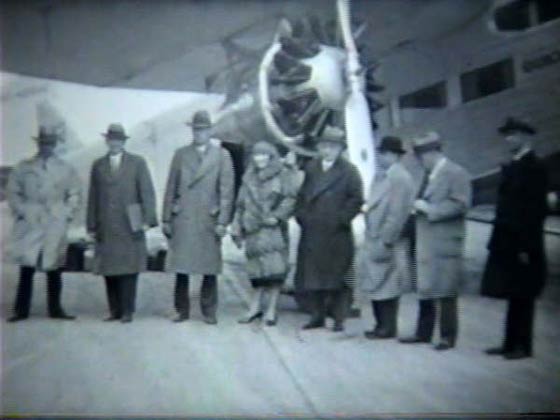 |
Ninth, another trimotor with a band playing under the wing. Does anyone KNOW the occasion?
Trimotor With a Band Playing Under the Wing, Date & Location Unknown (Source: Havrilla)
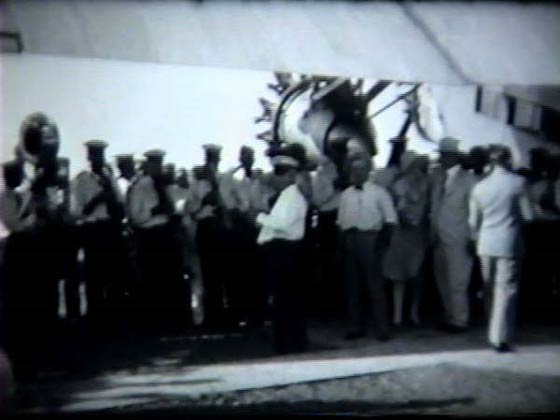 |
Tenth, what appears to be the aftermath of a landing accident with a Spartan School (St. Louis, MO) airplane.
Spartan School Aircraft Accident (Source: Havrilla)
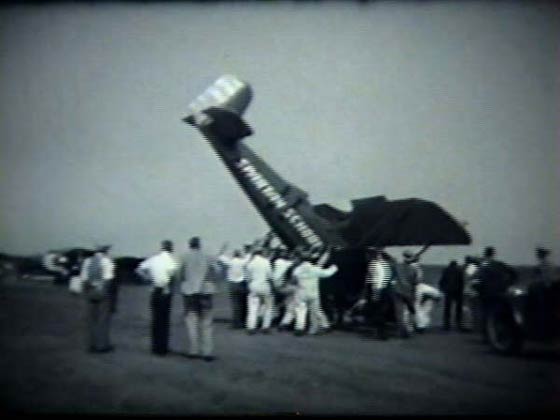 |
Eleventh, a view of a hangar at the Sweetwater, TX airfield. A few years later, Sweetwater would be a training center for WASP, the Women's Air Service Pilots of WWII.
Sweetwater, TX Airfield Hangar, Date Unknown (Source: Havrilla)
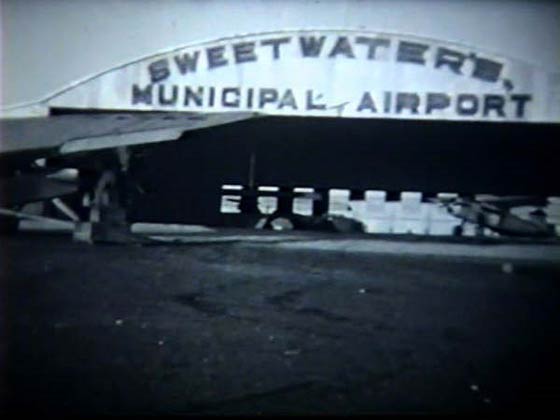 |
Twelfth, an unidentified Lockheed Vega.
Unidentified Lockheed Vega, Date & Location Unknown (Source: Havrilla)
 |
Finally, an unidentified Lockheed Sirius.
Unidentified Lockheed Sirius, Date & Location Unknown (Source: Havrilla)
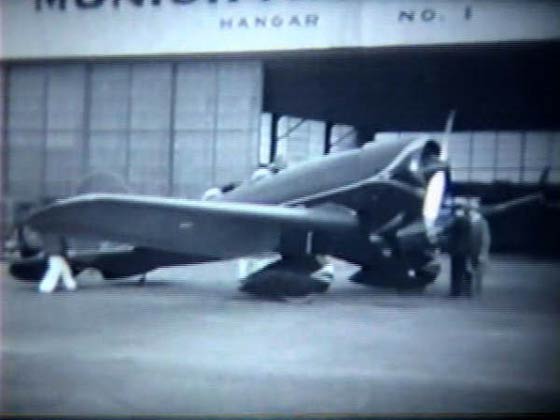 |
If you can identify any of the entities or circumstances above, please let me KNOW.
---o0o---
THIS PAGE UPLOADED: 05/11/10 REVISED:
|





















